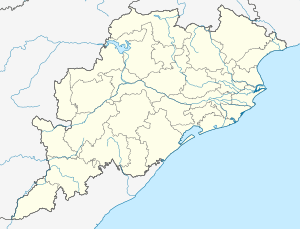Eram massacre
Eram is a small village in Basudevpur, Bhadrak from Odisha. It plays an important role in the history of Indian Independence movement.[2] It is also known as Rakta Tirtha Eram (The Pilgrim of Blood) and the second Jallianwala Bagh of India.
| Eram Massacre | |
|---|---|
 Eram’s Martyr Memorial | |
 Location of Bhadrak in India | |
| Location | Basudevpur, Bhadrak, Odisha, India |
| Coordinates | 31.64286°N 74.85808°E |
| Date | 28 September 1942 17:37 (6:30 p.m.) |
| Target | Gathering against the British rulers |
Attack type | massacre |
| Deaths | 29 [1] |
| Injured | ~ 60 |
| Perpetrators | British Indian Army unit under the DSP Kunjabihari Mohanty. |
No. of participants | 5000 |
Geography
Eram is located in Bhadrak district of Odisha and is 8 km away from Basudebpur village of Bhadrak district.
Role in Indian Independence Movement
The village Eram was remote, inaccessible and far from cities, surrounded by the Bay of Bengal and two rivers Gamoi and Kansbans and thick jungles the place was sleepy and silent to reach. From 1920, Eram was a secret place for Utkal Congress meetings, Gopabandhu Das, Harekrushna Mahatab and other Congress leaders used Eram as a place for public meetings to share the messages about Quit India Movement or Non-cooperation Movement of Mahatma Gandhi and to propagate the Gandhian ideals of freedom struggle among the villagers.[3]
1942 Mass attack incident
On 28 September 1942 there was a huge gathering at that place to protest against British Raj and to prepare a course plan of action to fight against British. Under the leadership of Kamala Prasad Kar a crowd of 5000 people gathered at Eram Melana ground. Afraid of this gathering a police force from Basudebpur police station, led by DSP Kunjabihari Mohanty march towards Eram. As like Jaliyanawala Bagh here, DSP Kunjabihari Mohanty acted as General Dyer and opened fire on the huge gathering at 6:30 PM, within few minutes 304 shots were discharged against the crowd,[4] who were performing the agitation against the British rulers in a peaceful way. Since the field was bounded on three sides,[5] therefore, no one was able to get escape from the field. Within some minutes 29 persons were dead on the spot and 56 were injured. Among the dead of Eram massacre includes one woman named Pari Bewa, who is regarded as the only lady martyr of Odisha. For this incident, Eram is popularly known as Rakta Tirtha Eram (The Pilgrim of Blood).
Martyrs list
- Pari Bewa, Eram, Basudebpur
- Gopal Chandra Das, Padhnuan
- Biswanath Das, Padhuan
- Bijuli Das, Padhuan
- Hrushikesh Behera, Padhuan
- Madan Palai, Padhuan
- Ballahaba Behera, Padhuan
- Magha Mahalika, Padhuan
- Bhua Majhi, Padhuan
- Kali Ajhi, Padhuan-Kumarpur
- Radhu Ahalika, Padhuan-Muladiha
- Dhruba Charana Dey, Padhuan
- Basudeb Sahu, Padhuan
- Hari Behera, Padhuan
- Dibakar Panigrahi, Guda-Kesagadia
- Krushna Chandra Swain, Padhuan-Kumarpur
- Bhaban Rout, Padhuan-Nandapura
- Nidhi Mahalika, Padhuan
- Brundaban Panda, Padhuan
- Upa Mallika, Nuangan
- Krupasindhu Behera, Sankharu
- Rama Majhi, Padhuan-Kumarpur
- Mani Behera, Padhuan
- Kati Sahu, Iswarapur
- Ratnakar Pani, Sudarsanpur
- Mani Pradhana, Suan-Sudarsanpur
- Pari Das, Suan
- Sankar Mallika, Adhunan
- Gobinda Rout, Artungan
- Panu Dash, Nuagaon[6]
In the memory of Martyrs, A martyrs’ memorial was built in Eram. It is one of the tourism places in Odisha.[7]
References
- http://orissadiary.com/Bhadrak/ShowDistrictNews.asp?id=36736
- Subas Pani; Harish Chandra Das; Indu Bhusan Kar (1988). Glimpses of history and culture of Balasore. Orissa State Museum. pp. 83, 84. Retrieved 14 August 2012.
- "Rakta Teertha Eram: The 2nd Jallianwala Bagh - Orissa POST". www.orissapost.com. Retrieved 2 August 2018.
- "Odisha Government Portal" (PDF). odisha.gov.in. Archived from the original (PDF) on 20 September 2016. Retrieved 2 August 2018.
- "Odisha Government Portal" (PDF). odisha.gov.in. Archived from the original (PDF) on 20 September 2016. Retrieved 2 August 2018.
- "Sangram Bhumi Bhadrak | Odisha State Archive". odishaarchives.nic.in. Retrieved 2 August 2018.
- "Bhadrakh District - Famous Temples, Tourist, Picnic Places". www.nuaodisha.com. Retrieved 2 August 2018.